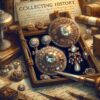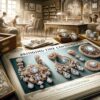A Glimpse into the Victorian Era: The Symbolism of Diamond Earrings
The Victorian Era, spanning from 1837 to 1901 during Queen Victoria’s reign, was a time of profound social, cultural, and technological change. This era brought about a fascination with symbolism and sentimentality in art, fashion, and jewelry. Among the many adornments that captured the essence of the Victorian era, diamond earrings emerged as a particularly potent symbol. In this article, we’ll take a closer look at the symbolism of diamond earrings during this period and the enduring legacy they have left on our understanding of the era’s culture.

Historical Context of the Victorian Era
The historical context of the Victorian Era is a tapestry woven with intricate threads of social, economic, and political change. At its core, this era was defined by the far-reaching effects of the Industrial Revolution, a seismic shift that reshaped the very fabric of society. The rapid advancement of manufacturing technologies and the emergence of factories revolutionized production, leading to increased urbanization as people flocked to cities in search of employment opportunities. This shift from agrarian life to urban living not only transformed the economic landscape but also altered the social structure.
One of the most profound consequences of this urbanization was the emergence of a burgeoning middle class. The once-clear lines that separated the aristocracy from the working class began to blur. With newfound economic opportunities, individuals who were not born into privilege could now aspire to attain a higher social status. This shift in demographics brought with it a heightened focus on social mobility and decorum. People were eager to display their refinement and status through their actions, choices, and appearances.
Amid this transformation, Queen Victoria’s influence on fashion and culture became a defining aspect of the era. Her ascension to the throne in 1837 marked the beginning of her lengthy reign, which would continue until 1901. Queen Victoria’s marriage to Prince Albert in 1840 set a romantic and aspirational tone for the entire Victorian period. Their union was not just a royal wedding; it became a symbol of love and devotion that captured the imaginations of the masses. Queen Victoria, known for her deep affection for her husband, played a pivotal role in shaping cultural norms, including those related to marriage, family, and, importantly, jewelry.
The royal couple’s celebration of love and their shared interests, such as the arts and sciences, set a standard for what was considered refined and tasteful in Victorian society. Their love story, which included the exchange of sentimental gifts and tokens, served as an inspiration to the populace. This influence extended to the world of jewelry and adornment, where couples sought to emulate the love and commitment of the royal pair through their choice of engagement and wedding jewelry.
Symbolism in Victorian Culture
The Victorians were deeply captivated by symbolism and sentimentality, both of which found expression in their art, literature, and fashion. Symbolism was a means to communicate emotions, sentiments, and hidden messages through various mediums. For example, the language of flowers, known as “floriography,” conveyed intricate meanings through the choice and arrangement of specific blooms. Similarly, gemstones held symbolic significance, with diamonds occupying a special place in the hearts of Victorians.
The Rise of Diamond Earrings
Earrings have graced human ears for centuries, serving as a timeless form of personal adornment. However, it was during the Victorian era that earrings experienced a remarkable resurgence in popularity and significance. Among the various earring styles that gained prominence, diamond earrings, in particular, emerged as a symbol of prestige, wealth, and romantic sentiment. Their allure extended beyond mere aesthetics, encompassing deep symbolism that resonated with the values and aspirations of the era.
Symbolism of Diamond Earrings:
Diamonds, with their dazzling brilliance and enduring strength, held a special place in Victorian society. They were revered as symbols of enduring love, purity, and unyielding strength. When worn as earrings, diamonds conveyed a profound message of constancy and commitment in romantic relationships. The act of gifting diamond earrings went beyond the exchange of exquisite jewelry; it was a tangible expression of love and devotion.
The symbolism of diamonds extended beyond matters of the heart. Victorians believed that diamonds possessed the power to bring clarity of thought and mental acuity to those who wore them. This belief in the cognitive and protective qualities of diamonds made them a favored choice for jewelry that carried both sentimental and practical significance. A woman adorned with diamond earrings was not only seen as a symbol of love and devotion but also as someone who possessed a sharp mind and an unwavering spirit.
Victorian Jewelry Trends:
While diamond earrings captured the imagination of the era, Victorian jewelry as a whole was marked by an extensive array of gemstones, each with its own unique symbolism. Lockets, brooches, rings, and other jewelry items were adorned with a rich tapestry of gemstones, including pearls, amethysts, garnets, and more. Each gemstone carried specific meanings and conveyed particular sentiments.
Victorian jewelry designs were characterized by intricate craftsmanship and motifs that reinforced the sentimental nature of the era. Hearts symbolized love, serpents represented eternal love and protection, and forget-me-not flowers conveyed lasting remembrance. These motifs and gemstones were thoughtfully combined to create pieces that told stories and carried deep emotional significance.
Famous Examples of Victorian Diamond Earrings:
The Victorian era witnessed the creation of exquisite diamond earrings that are now considered historical treasures. These earrings were crafted with meticulous attention to detail, reflecting the craftsmanship and aesthetics of the time. Settings and designs were often intricate, capturing the essence of Victorian beauty and sentimentality.
Notable individuals, including Queen Victoria herself, were known to possess and wear remarkable diamond earrings. Queen Victoria’s influence on fashion and culture was immense, and her endorsement of diamond earrings as symbols of love and devotion further solidified their cultural significance. The Queen’s own love for diamonds and the jewelry she wore set trends and served as inspiration for women across the Victorian era.
The Legacy of Victorian Diamond Earrings:
The symbolism of diamond earrings from the Victorian era endures to this day. While societal contexts have evolved, diamonds continue to symbolize love, commitment, and enduring beauty. Modern jewelry designers draw inspiration from Victorian aesthetics, incorporating elements of sentimentality and symbolism into their creations. Whether in engagement rings, wedding jewelry, or other adornments, diamonds remain a timeless embodiment of love and devotion, carrying forward the legacy of Victorian diamond earrings. They serve as a tangible connection to an era marked by its appreciation for intricate symbolism and the enduring power of sentiment.
Diamond earrings from the Victorian era offer us a captivating glimpse into the culture and values of the time. They reflect a society deeply enamored with symbolism, sentimentality, and the expression of emotion through art and fashion. Today, as we continue to admire and cherish these exquisite pieces, we pay homage to an era that left an indelible mark on the world of jewelry and sentiment. The symbolism of diamond earrings from the Victorian era is not merely a historical relic; it remains a testament to the enduring power of love, beauty, and the human desire to convey profound emotions through cherished adornments. The allure of these precious gems endures, reminding us of the timeless significance of love and commitment.


